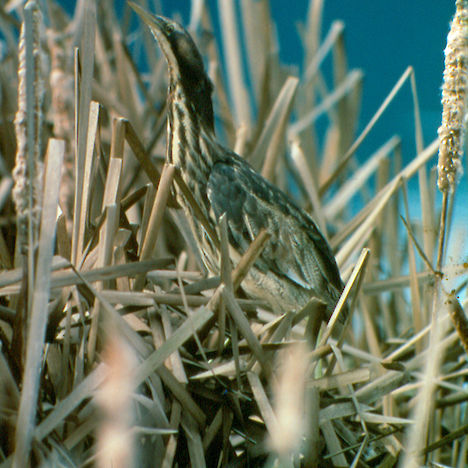Other names:
matuku, matuku hūrepoThreat category:
Threatened: Nationally Critical?Regions:
Northland, Auckland, Waikato, Bay of Plenty, Gisborne, Hawkes Bay, Manawatu-Wanganui, Taranaki, Wellington, Nelson-Tasman, Marlborough, Westcoast, Canterbury, Otago, SouthlandDistribution:
Throughout New Zealand
Description
- The Australasian bittern is a very large wetland bird that reaches c.70 cm in length.
- Males are considerably larger than females and weigh approximately 1.4 kg.
Interesting Facts
- Australasian bittern is a highly cryptic species that is rarely seen.
- The species is extremely rare in New Zealand, and is thought to number less than 900 individuals. However, it is very hard to survey so actual numbers are difficult to assess.
- The bittern is also found in Australia and New Caledonia where it is also very rare, and thought to number less than 1,000 and 50 individuals respectively. Numbers in Australia are considered to be in rapid decline.
- It is highly secretive and feeds mostly at night on fish, eels, frogs, insects and other aquatic life.
- The male call sounds like a foghorn and this call is used to monitor the species at dusk or dawn.
- It is not known if the species is impacted by introduced terrestrial predators as the species has rarely been studied.
- All wetland birds require high quality wetland habitat buffered from the effects of surrounding land management.
Association with Plantations
- Wetland birds are found in many plantation forests.
- Wetland birds may be hard to detect due to their elusive behaviour.
Threats
- Habitat loss and degradation from wetland drainage, loss of riparian margins, and the effects of surrounding landuse.
- Invasion of exotic plants, which can seriously modify wetlands and reduce suitability for birds.
- High predation rates of wetland birds, particularly brown teal/pateke mainly from dogs, cats and mustelids.
- Mammalian predation may also affect some other wetland bird species, but the extent of the impacts is unknown.
Management Options and Methods
- Habitat protection:
- Protect important wetland habitats and riparian buffers.
- Avoid using herbicides or pesticides close to wetlands.
- Ensure weeds are not inadvertently introduced to wetlands, e.g. via machinery or boats.
- Consider control options for existing, invasive, wetland weeds.
- Consider a staged removal of willows to ensure ongoing cover for crakes and ducks.
- Forest operations:
- Minimise damage to riparian and wetland habitat during road construction and harvest operations.
- Avoid grazing wetlands and their margins. Fencing may be appropriate in some situations.
- Avoid diverting run-off into wetlands.
- Minimise disturbance during spring breeding.
- If pateke are present, discuss predator control with neighbours and DOC.
- Injured or dead wetland birds (particularly the more threatened species, i.e. white heron, bittern and pateke):
- Place injured birds in a cardboard box (keep shaded) and deliver to a local vet, SPCA, DOC.
- Call DOC if bird is dead.
Monitoring Options
- Increase staff and contractor knowledge about wetland birds.
- For important wetlands that are likely to have the more threatened species, consider undertaking a bird monitoring programme:
- Counts of pateke flock sites in late summer.
- Fernbirds, spotless crakes and to a lesser extent marsh crakes and banded rails respond to taped playback calls.
- The booming calls of bittern are characteristic at dusk in September-October particularly during bright moonlight.
- Maintain a database of sightings.
Further Information and Support
- New Zealand Birds Online: Australasian bittern.
- Department of Conservation website: Australasian bittern.
- Wetland Restoration: A Handbook for New Zealand Freshwater Systems. Landcare Research - Manaaki Whenua.
- Pest management - Department of Conservation, Regional Councils.


